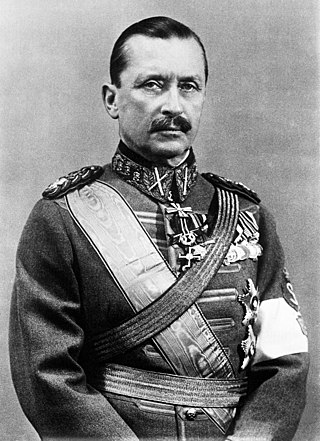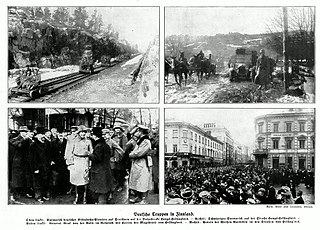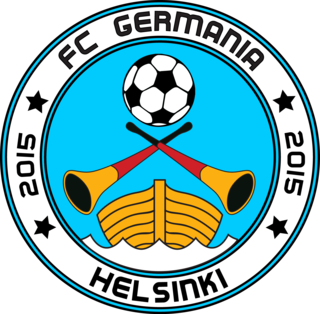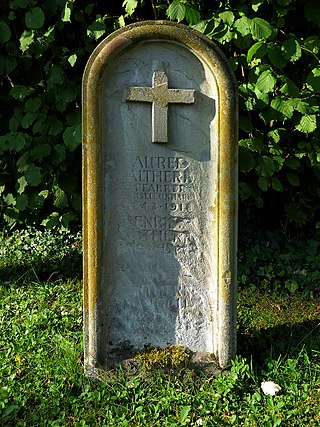
Kyösti Kallio was a Finnish politician who served as the fourth president of Finland from 1937 to 1940. His presidency included leading the country through the Winter War; while he relinquished the post of commander-in-chief to Carl Gustaf Emil Mannerheim, he played a role as a spiritual leader. After the war, he became both the first President of Finland to resign and the only one to die in office, dying of a heart attack while returning home after submitting his resignation.

Baron Carl Gustaf Emil Mannerheim was a Finnish military leader and statesman. He served as the military leader of the Whites in the Finnish Civil War (1918), as Regent of Finland (1918–1919), as commander-in-chief of the Finnish Defence Forces during the period of World War II (1939–1945), and as the sixth president of Finland (1944–1946). He became Finland's only field marshal in 1933 and was appointed honorary Marshal of Finland in 1942.

Pehr Evind Svinhufvud af Qvalstad was the third president of Finland from 1931 to 1937. Serving as a lawyer, judge, and politician in the Grand Duchy of Finland, which was at that time an autonomous state under the Russian Empire’s rule, Svinhufvud played a major role in the movement for Finnish independence. He was the one who presented the Declaration of Independence to the Parliament.

Greater Finland, was an irredentist and nationalist idea that was a subset of Pan-Finnicism which emphasized the territorial expansion of Finland. The most common concept of Greater Finland saw the country as defined by natural borders encompassing the territories inhabited by Finns and Karelians, ranging from the White Sea to Lake Onega and along the Svir River and Neva River—or, more modestly, the Sestra River—to the Gulf of Finland. Some proponents also included the Torne Valley, Ingria, and Estonia.

Mario Pasquale Comensoli was a Swiss painter. He is considered as leading figure of the realist movement, depicting the social evolution of post-World War II Switzerland with key themes ranging from Italian immigrants to the 1968 social unrest, the Disco years and the hopelessness of the 'No Future' youth.

Detachment Brandenstein was a unit of the Imperial German Army commanded by Otto von Brandenstein that fought for the White Finns during the Finnish Civil War. The 3,000 man unit was assembled in Tallinn and landed at Loviisa on 7 April 1918. Its assigned mission was to control Eastern Uusimaa to cut the Red Finns' railway connections between Helsinki and Viipuri. The major operation for Detachment Brandenstein was the Battle of Lahti from 19 April to 1 May.
Swiss Standard German, or Swiss High German, referred to by the Swiss as Schriftdeutsch, or German: Hochdeutsch, is the written form of one of four official languages in Switzerland, besides French, Italian, and Romansh. It is a variety of Standard German, used in the German-speaking part of Switzerland and in Liechtenstein. It is mainly written, and rather less often spoken.

Ufenau is an island located, with the neighbouring island of Lützelau, in Lake Zürich in Switzerland between Freienbach and Rapperswil. Highlights on Ufenau include St. Peter & Paul church, St. Martin's chapel, and Ufenau's idyllic landscape in the Frauenwinkel protected area.

The Swiss Northeastern Railway was an early railway company in Switzerland. It also operated shipping on Lake Constance (Bodensee) and Lake Zürich. Until the merger of the Western Swiss Railways into the Jura–Simplon Railway (JS) in 1890/91, it was the largest Swiss railway company.

The Finnish military administration in Eastern Karelia was an interim administrative system established in those areas of the Karelo-Finnish Soviet Socialist Republic (KFSSR) of the Soviet Union which were occupied by the Finnish army during the Continuation War. The military administration was set up on 15 July 1941 and it ended during the summer of 1944. The goal of the administration was to prepare the region for eventual annexation by Finland.

About a quarter of a million German nationals had permanent residence in Switzerland in 2009, rising to some 300 thousand five years later. Accounting for multiple citizenships the number of German nationals living in Switzerlands is much higher, at about 450,000 in 2019. For the Germans, Switzerland became the most appreciated country to settle in, to find work or to study. The "surge" of immigration during the first decade of the 21st century, especially the German one, is a result of the EU-15 opening and, for students, of the Bologna Process.

Das Hilfswerk für die Kinder der Landstrasse, more commonly known as Kinder der Landstrasse, was a project implemented by the Swiss foundation Pro Juventute from 1926 to 1973. The project aimed to assimilate the itinerant Yenish people in Switzerland by forcibly removing their children from their parents and placing them in orphanages or foster homes. Approximately 590 children were affected by this program.
Beobachter (Observer), also known by its former name Der Schweizerische Beobachter, is a German-language Swiss magazine. Published in Zürich, its 26 issues a year focus on consumer, health and political content.

Gerold Späth is a Swiss author, poet and writer.
Germans in Finland are immigrants from Germany residing in Finland.
Max Leo Keller was a Swiss engineer and politician of the Fronts Movement.

FC Germania Helsinki (FCGH) is a sports club from Greater Helsinki, Finland, playing association football.

Alfred Altherr was a Swiss Protestant clergyman and writer from the canton of Appenzell Ausserrhoden.

Johannes Wilhelm Öhquist was a Finnish civil servant, language teacher, art historian and politically active writer. He promoted cultural relations between Germany and Finland and disseminated information about Finland in German. He later sought to spread the idea of Nazism to Finland. Johannes Öhquist was the father of Lieutenant General Harald Öhquist.















